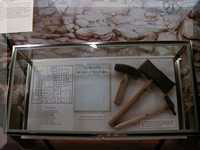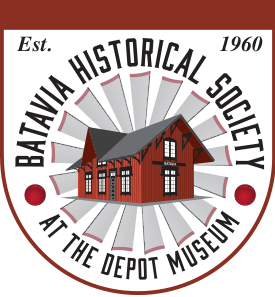Nearly from its beginning, Batavia was an industrial city. Farm implement and windmill factories provided employment for many. The first products manufactured in Batavia (flour, ice, lumber, paper, stone) found markets in Chicago.
Batavia’s significant industries are identified with the following Categories. Click any category from the menu above for the history and involvement of companies from Batavia.
Quarrying began in 1834 when Joseph Lyon dug limestone to line the walls of his well. In 1842, Zerez Reynolds opened a quarry for commercial use. Batavia had at least ten quarries operating in 1860.
There were four east-side quarries between the south end of River Street and the Burlington Northern tracks. Later they became a part of James Shannon’s quarry. Shannon used his stone to build the original McWayne School on First Street in 1867, the Main Street bridge in St. Charles, and the original Holy Cross Church. South of the Shannon quarry was the Randall and Stephens Quarry. Stephens built the Methodist Church on North Batavia Avenue.
In 1852, James Derby and Lawrence Barker, paid $1,000 for an acre of quarry land and opened operations at the east end of Walnut Street on the west side of the river. Eventually, the operation became known as L. P. Barker and Son. Later Barker bought 5 1/2 more acres of quarry land for $2,000 an acre and acquired the adjoining Coffin, Booth, and Whipple quarries.
Barker’s was to become the largest quarrying operation in Batavia, employing from 35 to 40 men in 1887. That year, a tramway was installed to elevate the stone to ground level. Some time prior to 1873, the North-Western road had placed a sidetrack into the Barker quarry and was able to load by means of derricks direct from the quarry onto the railroad cars.
Barker’s quarry could produce forty cords of limestone a day. The blocks of stone measured from 2 to 10 inches thick and from 9 to 20 feet long. The men had dynamite to loosen the rock from the ground, but they had to shape the rocks by hand with only primitive tools.
Old accounts tell of the blasting that took place, shaking homes near the quarries. This led to the city banning any further mining for fear South Water Street might collapse into the hole. And without much to do, the quarries closed shortly after 1900.
Stone from the Barker quarry went into the building of the Chicago and Northwestern bridge in Geneva and the Challenge Company buildings. A great deal of stone went into the rebuilding of Chicago after the 1871 fire and the construction of Northern Illinois University in DeKalb. Many stone buildings still stand in Batavia.
Water seepage from underground springs filled the holes made by the west side quarries. In 1920, Frederick H. Beach bought the land on which the Barker quarry stood and donated it to the Township Park Board. A swimming area was created, and the area was named the Frederick H. Beach Park and Pool. In June 1993, a beautiful restored facility was unveiled, and the swimming area is now the Harold A. Hall Quarry Beach in Frederick Beach Park.

Quarrying Tools

